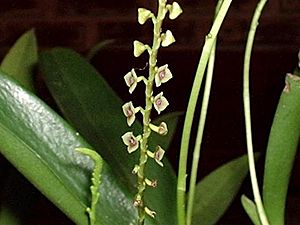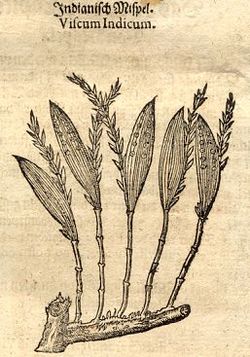Leach orchid facts for kids
Quick facts for kids Leach orchid |
|
|---|---|
 |
|
| Silvery stelis (Stelis argentata) | |
| Scientific classification |
|
| Kingdom: | Plantae |
| Clade: | Tracheophytes |
| Clade: | Angiosperms |
| Clade: | Monocots |
| Order: | Asparagales |
| Family: | Orchidaceae |
| Subfamily: | Epidendroideae |
| Tribe: | Epidendreae |
| Subtribe: | Pleurothallidinae |
| Genus: | Stelis Sw., 1799 |
| Synonyms | |
|
|
Stelis, also known as leach orchids, is a very large group of orchids. There are about 500 different kinds, or species, of Stelis orchids. The name Stelis comes from a Greek word meaning 'mistletoe'. This is because these orchids often grow on other plants, just like mistletoe does.
These orchids are mostly epiphytic, meaning they grow on trees. Sometimes, they can also be lithophytic, growing on rocks. You can find them across a wide area, including most of South America, Central America, Mexico, the West Indies, and even Florida.
Many older Stelis species were named by famous botanists like John Lindley, Ruiz & Pavon, and Heinrich Gustav Reichenbach. More recently, Dr. C. Luer has named many new species. An orchid from the Stelis group was likely the first American orchid ever brought to Europe. A drawing of one was shown in a plant book by Tabernaemontanus in 1591.
Contents
What Stelis Orchids Look Like
Stelis orchids have a single, long, and somewhat spoon-shaped leaf. This leaf grows from a narrow, tough stem that often creeps along.
Most Stelis species have long, thick clusters of tiny flowers. These flowers are usually white, but other colors are rare. The flowers are special because they are sensitive to light. They only open up when the sun is shining and often close completely at night.
The flowers have three rounded parts called sepals. These sepals usually form a triangle shape. In the middle of this triangle, there's a small structure made up of the column, tiny petals, and a small lip. While this is the general look, there can be small differences between species.
You won't often find these orchids growing in people's homes or gardens. They are not very common in plant collections.
Stelis Orchid Family Tree
Scientists have studied Stelis orchids to understand their family connections. Research shows that all Stelis orchids are closely related to each other. They are also very close relatives of the huge orchid group called Pleurothallis and another group called Masdevallia.
Even though different Stelis species can look quite different in their leaves and stems, their flowers are usually very similar. Some other orchid groups, like Apatostelis, Dialissa, Humboldtia, and Steliopsis, are now considered part of the Stelis group.
How Stelis Orchids Were Discovered
The Stelis orchid group was first found by Charles Plumier. He was a French priest and botanist sent by King Louis XIV to study plants in the Antilles around 1690. He collected many plants in Dominica and other islands. He wrote about his discoveries in a book called Nova Plantarum Americanarum Genera in 1703.
Later, Nikolaus von Jacquin, a Dutch botanist, also collected plants in the Caribbean. In 1760, he described a plant that was the same as Plumier's. He published more details in 1763.
After that, a Spanish plant expedition went to Peru and Chile. On this trip, Hipolito Ruiz and Joseph Pavon found 11 small plants of a new group. They named this group Humboltia, honoring the famous German explorer Alexander Von Humboldt.
However, in 1799, a Swedish botanist named Olof Swartz studied this new group. He found that the name Humboltia had already been used for another type of plant. So, he suggested the new name Stelis instead. The plant that Jacquin described earlier was later moved into the Stelis group by Swartz. This plant, Epidendrum ophioglossoides, is now the main example species for the entire Stelis group.
Types of Stelis Orchids
Here are some of the many different kinds of Stelis orchids:
- Stelis alata Lindl. – winged stelis
- Stelis argentata Lindl. – silvery stelis
- Stelis aviceps Lindl. – bird head stelis
- Stelis barbata Rolfe – bearded stelis
- Stelis bidentata Schltr – two-toothed stelis
- Stelis ciliaris Lindl. – hairy stelis
- Stelis crescentiicola Schltr – Crescentia living stelis
- Stelis dalstroemii Luer
- Stelis flexuosa – flexuous stelis
- Stelis gemma – gem stelis
- Stelis glomerosa – ball stelis
- Stelis guatemalensis – Guatemalan stelis
- Stelis intermedia Poepp. & Endl. – in-between stelis
- Stelis leinigii – Leinig's stelis
- Stelis megantha – giant anther stelis
- Stelis palmeiraensis – Palmeira stelis
- Stelis pauciflora Lindl.
- Stelis papaquerensis Rchb.f.
- Stelis perpusilliflora – West Indian leach orchid
- Stelis porschiana – Porsch's stelis
- Stelis purpurea – purple stelis
- Stelis pygmaea – pygmy leach orchid
- Stelis triangulisepala – triangular sepal stelis
See also
 In Spanish: Orquídea colada para niños
In Spanish: Orquídea colada para niños


